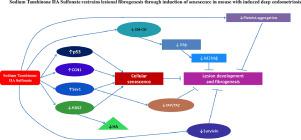Reproductive BioMedicine Online ( IF 4 ) Pub Date : 2020-05-03 , DOI: 10.1016/j.rbmo.2020.04.006 Min Luo 1 , Xianjun Cai 1 , Dingmin Yan 2 , Xishi Liu 3 , Sun-Wei Guo 3

|
Research question
Does sodium tanshinone IIA sulfonate (STS) induce cellular senescence in endometriotic lesions and thus restrict lesional development and fibrogenesis in a recently established mouse model of deep endometriosis?
Design
Prospective randomized animal experiment in which deep endometriosis was induced in female Balb/C mice, which were then randomly divided into three groups (low-dose STS, high-dose STS and inert vehicle control) and received treatment for 2 weeks. All mice were then sacrificed and their lesions excised and harvested. Lesion weight was quantified and all lesion samples were subjected to histochemical analysis of the extent of lesional fibrosis by Masson trichrome staining, and of cellular senescence by senescence-associated β-galactosidase (SA-β-gal), along with immunohistochemistry analyses of p53, CCN1, activate Salvador 1 (Sav1), hyaluronan synthase 2 (HAS2), survivin, granulocyte-macrophage colony-stimulating factor (GM-CSF) and CD163-positive M2 macrophages. Plasma P-selectin and hyaluronic acid levels were also quantified. Hotplate testing was also administered before the induction, then before and after treatment.
Results
STS treatment resulted in significantly reduced lesion weight, stalled lesional fibrogenesis and improved hyperalgesia, seemingly through the induction of cellular senescence by activating p53, Sav1 and CCN1 while suppressing HAS2, survivin and GM-CSF, resulting in increased apoptosis and reduced lesional infiltration of alternatively activated macrophages. In addition, STS treatment significantly reduced the plasma concentration of P-selectin and hyaluronic acid, possibly leading to reduced lesional platelet aggregation.
Conclusions
STS appears to be a promising compound for treating endometriosis. The results suggest that senescence may restrict lesional progression and fibrogenesis, and targeting the senescence pathway may have desirable therapeutic potential.
中文翻译:

丹参酮 IIA 磺酸钠通过诱导深部子宫内膜异位症小鼠衰老抑制纤维化。
研究问题
在最近建立的深部子宫内膜异位症小鼠模型中,丹参酮 IIA 磺酸钠 (STS) 是否会诱导子宫内膜异位病变的细胞衰老,从而限制病变的发展和纤维化?
设计
前瞻性随机动物实验,在雌性 Balb/C 小鼠中诱导深部子宫内膜异位症,然后将其随机分为三组(低剂量 STS、高剂量 STS 和惰性载体对照)并接受治疗 2 周。然后处死所有小鼠并切除并收获它们的病变。对病灶重量进行量化,并对所有病灶样品进行 Masson 三色染色对病灶纤维化程度的组织化学分析,以及通过衰老相关 β-半乳糖苷酶 (SA-β-gal) 对细胞衰老进行的组织化学分析,以及对 p53、 CCN1,激活 Salvador 1 (Sav1)、透明质酸合成酶 2 (HAS2)、存活蛋白、粒细胞-巨噬细胞集落刺激因子 (GM-CSF) 和 CD163 阳性 M2 巨噬细胞。血浆 P-选择素和透明质酸水平也被量化。
结果
STS 治疗导致病灶重量显着减少、病灶纤维化停滞和痛觉过敏改善,似乎是通过激活 p53、Sav1 和 CCN1 诱导细胞衰老,同时抑制 HAS2、存活蛋白和 GM-CSF,导致细胞凋亡增加并减少病灶浸润。活化的巨噬细胞。此外,STS 治疗显着降低了 P-选择素和透明质酸的血浆浓度,可能导致病变血小板聚集减少。
结论
STS 似乎是治疗子宫内膜异位症的有前途的化合物。结果表明,衰老可能会限制病变进展和纤维化,靶向衰老途径可能具有理想的治疗潜力。



























 京公网安备 11010802027423号
京公网安备 11010802027423号